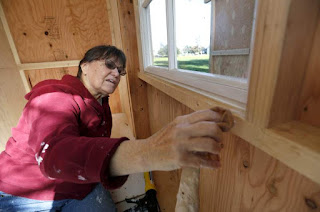1) What
is Homeless Talk?
Homeless Talk is a series of twenty-five or more facilitated open-ended
large group discussions in community centers, clubs, congregations, and private
homes in Santa Rosa to share thoughts on homelessness.
Our mission: To engage our community in conversation regarding
homelessness in our city with no 'Homeless Talk' bias, judgment, opinions or
specific agendas put forth. Our aim and commitment is to take your community
voice and present it where it may have an influence on solutions.
Hosting a Homeless Talk:
2) As a Host of a Homeless
Talk meeting, what are you asking of me?
This job includes interfacing with
the people who own the building where it will be held (if it is someone
other than yourself) planning the date, inviting people, setting up the room
before the meeting and cleaning up afterward. Snack food is optional.
Your group may provide food or it may come from the Steering Committee.
Homeless Talk will provide a facilitator and format for the meeting, and
pay any agreed-upon fees. We will bring handouts and other materials,
provide note taking, and help with set up and cleanup. In addition, at
least one steering committee member will work closely with you as you set up
the event.
3) Who will do the publicity
to get people to the meeting I am hosting?
This is a collaborative task.
Homeless Talk will publicize every
meeting in the newspapers and other standard outlets, as well as on our
Facebook page and through our newsletter. We will publicize our effort as
a whole, as well as telling people about upcoming meetings. We may
provide targeted publicity in your neighborhood or to specific groups of
people. We will put posters and other signage on the building the day of
the event.
We hope you will invite neighbors,
colleagues, friends and family, as well as using the mailing lists of any
organization that is involved.
4) Is there money to cover the
cost of any mailing I might do, or brochures?
There will be some money but we are still
raising it. And, by the way, in-kind and monetary donations are tax
deductible. As you are planning your meeting, talk with your steering
committee representative about the specific amount you need and we will attempt
to get it to you.
5) As a host, will I have to
speak and if so what will I be asked to say?
You do not have to speak if you
don’t want to, however, we would be honored if you would welcome those who
come, provide information about the building (location of bathrooms etc, and
thank anyone who has helped you. At the least, we would like to
acknowledge you and your work during the meeting.
6) Who will facilitate the
conversations?
We are training a cadre of volunteer
facilitators. Many of them will come from Sonoma State University’s
Organization Development Masters Program, where they have become skilled
facilitators. We hope to have two facilitators at each meeting as well as
a note taker. Please tell us if you would like to facilitate or know
someone who could fill that role.
7) How will information be
collected?
At the least there will be note
taking at each meeting. In addition, we will have a brief survey at each
meeting that will also be on-line. We are looking into more intensive
methods of collecting information.
8) How many people will be at
each conversation?
There is no requirement or minimum
for a conversation. We are hoping that each one will draw between 10 and
30 people but that will depend on you as the host, the sponsoring organization
(if there is one), and Homeless Talk.
9) How long will a meeting be?
The formal meeting will last 90
minutes (1½ hour). Please plan an additional 30 min. for set up and try
to keep the room available for 30-45 min. afterward for extended discussions
and clean up.
10) Is there a bias in these
conversations? If so, what is it?
Our bias is the radical belief that
people can figure out their problems themselves, even large problems like
homelessness. We believe that bringing people in Santa Rosa together in
groups with some help from a facilitator will provide the next set of solutions
for the issues of homelessness. We will talk about the issues that
individuals bring into the room with them. The facilitators will be
trained to encourage everyone to talk and to exhibit no judgments.
Find the Everyday Democracy talk in
Santa Rosa here:
11) What do I do next?
a) Take a look at your
calendar. Do you have some time between now and November, when you could
organize a conversation? (If so, see #6 above.)
b) Contact your prospective
organization or building and find out whether they would help you by providing
the room and any publicity.
c) Find a couple of evening or
weekend dates that work for everyone,
d) Contact us to get a
steering committee representative.
e) Confirm a date and begin
working on the details.
General Questions:
12)
How will information from Homeless Talk be used?
We will collate responses to these
questions as well as other information from formal and informal meetings.
When we finish this round of meetings & discussions, we will prepare
a report that will be released to the public. Your name will not be used
unless you give us specific permission. We expect the Santa Rosa City
Council, the Sonoma County Board of Supervisors, Social Service Agencies,
Business Owners, Neighborhood Groups and Individuals to find the information
useful when issues of homelessness arise.
13) How can I help? There are many ways you can support this project, by
attending a Homeless Talk Conversation, helping with publicity, grant writing,
food or drink donations or a tax deductible contribution. Our contact
information is below. Please get in touch. One of the most useful
things you can do is to become a host for a specific Homeless Talk
Conversation. It's easy.
14) How can I make a donation?
Make your check out to our fiscal
sponsor LIFEE, Leadership Institute for Ecology and the Economy, put “Homeless
Talk” in the memo line and mail to 9826 Keith Court, Windsor, 95492.
Donation through LIFEE are tax deductible.
Or contact the steering committee
through the e-mail or phone number below.
15) Who is on the Steering
Committee of Homeless Talk?
Our volunteer steering committee
members are Gregory Fearon, Pat Kuta , Hank Topper,& Lawrence Lehr from Santa Rosa Together, Adrienne Lauby and
Cynthia Stebbins from Homeless Action!, Cecile Querubin, Organization Development
Consultant, and Hrieth Anet Pezzi, community educator and group process
consultant. Cynthia brings her experience as a homeless woman to the
group.
16) Are there formal
partnerships and, if so, with whom? Who are the people connected with these
partnerships?
Our strongest coalition members are
from Santa Rosa Together and Homeless Action! (see above for individual names)
We have asked the City of Santa Rosa to become a formal partner and
hope to grow the coalition further. We have the support of individual
Santa Rosa City Council members, some of whom will be hosting conversations.
17) Have there been open
planning meetings about this? If so, who are in those groups?
Since the Fall of 2015 the Homeless
Talk Steering Committee has held 5 open planning meetings which included a wide
variety of people. A partial list: Anita LaFollette, Beth Dadko,
Chuck Cornell, Chris Coursey, Georgia Berland, Ernesto Oliveras, Enrique Yarce
Martinez, Hank Topper, Jim Leddy, Jennielynn Holmes, Jim Sweeney, Lawrence
Lehr, Michael Gauss, Betsy Hall, Sheila Baker, Tim Carnahan, Tanya Narath,
Jackie Brittain, Rene Riggs, Thomas Ells, Tom Schwedhelm…
Organizations and groups included the Junior College Student
Government, several churches, the Santa Rosa School District, Sonoma County,
Burbank Housing, City of Santa Rosa, Homeless Action!, Santa Rosa Together and
homeless individuals.
18) Are the city or county
involved and, if so, how?
Staff members from Sonoma County
attended our early meetings and helped us plan our initial strategy. Both
staff and Council Members from the City of Santa Rosa have also attended
meetings and offered their encouragement. We do not have a formal
relationship with either governmental group at this time.
19) How can I reach you?
To volunteer to host or for any
other questions,


















